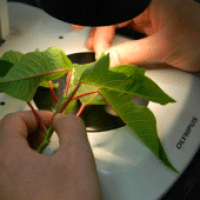- Home › News & Highlights › Investments Though Farming Power Program Improve Greenhouse Energy Efficiency


Investments Though Farming Power Program Improve Greenhouse Energy Efficiency
Written by Katie Gibb for the Ontario Soil and Crop Improvement Association
Guelph, ON - It’s no secret that this past winter was a chilly one complete with record amounts of snowfall and lower than normal temperatures. While at home our furnaces ran around the clock keeping us cozily toasty, this year presented a real challenge for greenhouse operators to keep their plants warm with just a double layer of poly or acrylic separating the growing environment from this frosty Ontario winter.
However, at Ken and Karen Tigchelaar’s greenhouse operation near Sheffield, Ontario, a boiler system with a difference was keeping their plants alive and well. The Tigchelaars have been watching their fuel costs over the past 25 years and since they do not have natural gas in their area they began looking into alternatives for their greenhouse’s oil heating system.
In 2005, they invested in a biomass boiler system that burns wood pellets. The boiler was about 80 to 85% efficient, but they knew they were losing heat up the stack. When they found out about the Farming Power program in the fall of 2013, it gave them the opportunity to invest in an economizer which captures heat from the exhaust gases going up the boiler stack, allowing them to use it exactly where it’s needed – in the greenhouse.
The economizer improves the boiler system’s efficiency by about 10 to 15%. The heat in the stack is transferred to water in the heat exchanger where it is stored in a tank or transferred directly to the greenhouse. In the daytime, the sun provides plenty of heat for the greenhouse through solar gain. The shell-in-tube boiler runs during the day and the heat from the boiler along with the economizer is stored in a tank of water when it’s not needed. The hot water is drawn off the tank to heat the two-acre greenhouse operation as the temperature begins to drop.
“The Farming Power program allowed us to move forward sooner with the investment in the economizer,” says Ken. “The cost-share program was a great benefit to our operation and improving energy efficiency for the long term.”
The Tigchelaars spend about $60,000 per year on wood pellets for heating. Ken remarks that if this year was 10 to 15% colder than previous years, their heating fuel bill wouldn’t have increased because of the economizer savings. “It certainly helps,” he adds.
K&K Greenhouses is a family-run business. Each one of Ken and Karen’s four children help out and work in the greenhouse, which produces container plants. The Tigchelaars are making investments like these to ensure the on-going success of their business for the next generation.
"Greenbelt farmers, like the Tigchelaars, are on the cutting edge when it comes to innovations that help protect the environment and help grow their business," said Burkhard Mausberg, CEO of the Friends of the Greenbelt Foundation. “By partnering with the OSCIA, we are providing the solution to keeping our environment healthy, while also supporting substantial, long-term economic benefits for farmers.”
Farming Power was a cost-share program that provided farm businesses with funding to improve on-farm energy efficiency in the Greenbelt. It allowed participants to implement select Best Management Practices focused on lighting, refrigeration, cooling and heating upgrades to increase energy efficiency on agricultural operations. The program was funded by the Friends of the Greenbelt Foundation and delivered though the Ontario Soil and Crop Improvement Association for the 2013 cropping season.
-30-
For more information, contact Christine Schmalz at christine.schmalz@
Categories
Event Calendar
The Latest from Greenhouse Canada
Dipping Cuttings to Start Clean
Vineland researchers are working with Flowers Canada and OMAF & MRA to get cutting dips on the labels.Hitchhiking whitefliesPoinsettia…



